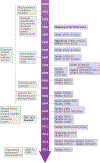Rare neurological channelopathies--networks to study patients, pathogenesis and treatment
- PMID: 26943780
- PMCID: PMC6609097
- DOI: 10.1038/nrneurol.2016.18
Rare neurological channelopathies--networks to study patients, pathogenesis and treatment
Abstract
Each of the thousands of rare neurological diseases requires a widely distributed network of centres, investigators and patients, so as to foster multidisciplinary investigations and involve sufficient numbers of patients in the discovery of disease pathogenesis and novel treatment. In this Review, we highlight the value of this collaborative approach in patient-oriented research into rare neurological channelopathies. Two networks, the Consortium for Clinical Investigations of Neurological Channelopathies (CINCH) and the Clinical Research Consortium for Studies of Cerebellar Ataxias (CRC-SCA), provide a link between patients with rare channelopathies and investigators who are studying disease pathogenesis and developing novel treatments. Interactions between patients, researchers and advocacy groups promote shared agendas that benefit patient education and recruitment, research collaboration and funding, and training and mentoring of junior investigators who are attracted to the study of the diseases that provide the focus for the two networks. Here, we discuss how linkage of national and international centres has enabled recruitment of study participants, provided opportunities for novel studies of pathogenesis, and facilitated successful clinical trials.
Figures


References
Publication types
MeSH terms
Grants and funding
LinkOut - more resources
Full Text Sources
Other Literature Sources

